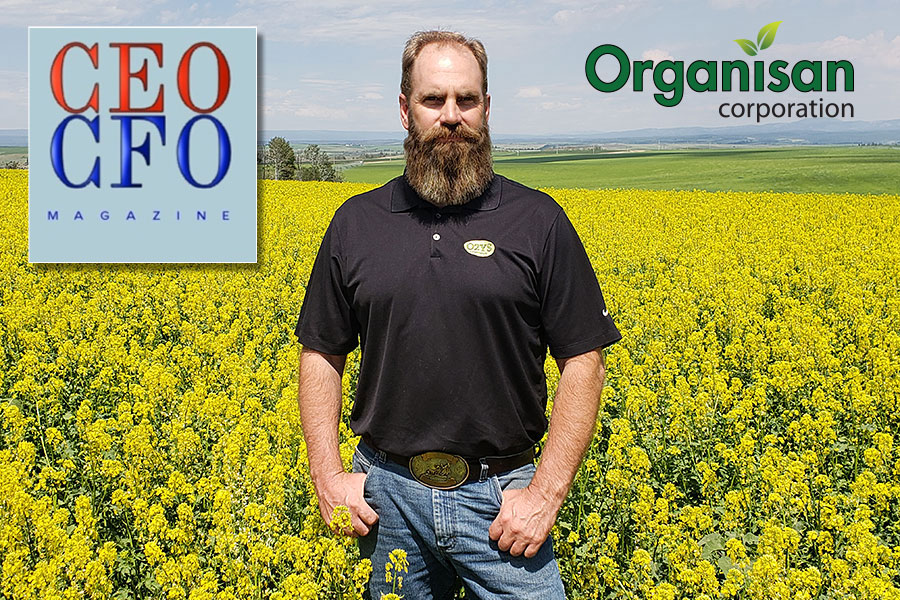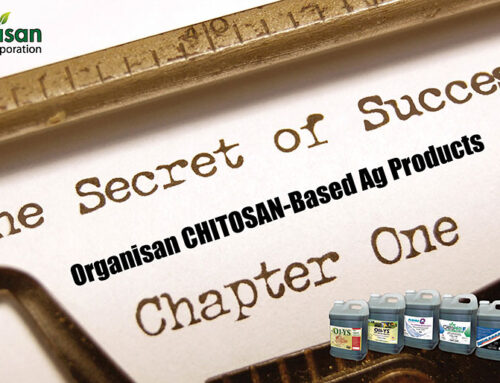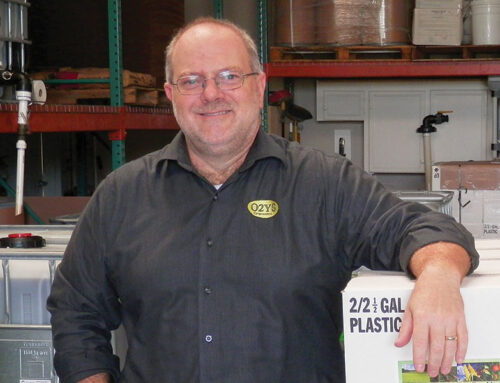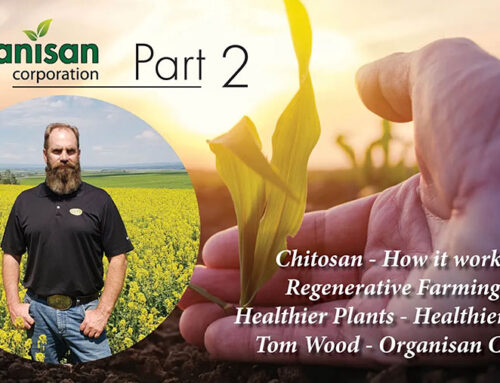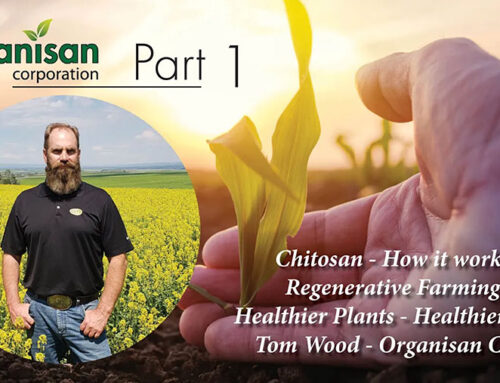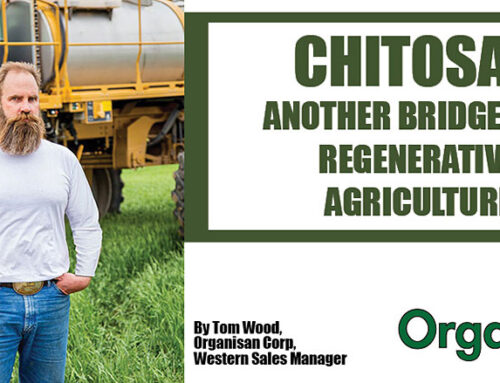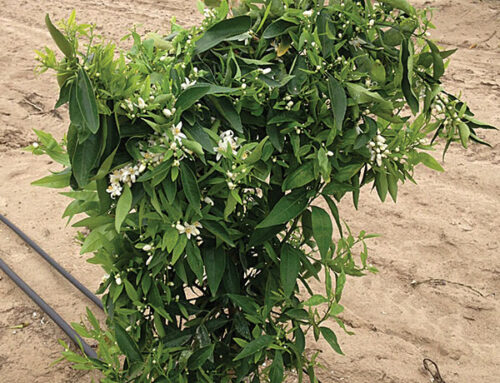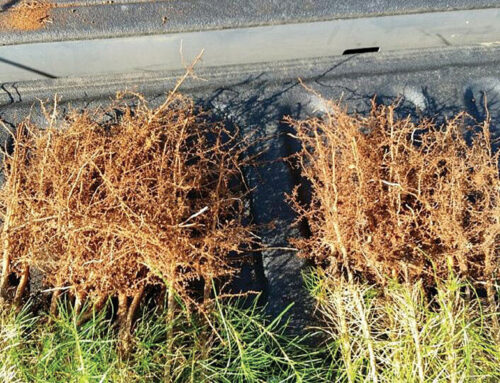Spokesperson for Organisan Corporation, Tom Wood Shares How They are Using Chitosan Products to Help Farmers Combat Plant Disease and Fungus While Improving Nutrition Without Using Chemicals and Synthetic Products
Tom Wood, Spokesperson, Organisan Corporation
Interview conducted by: Bud Wayne, Editorial Executive, CEOCFO Magazine
ceocfointerviews.com, © All rights reserved, Issue: October 4, 2023
CEOCFO: Mr. Wood, before we get into what you are doing at Organisan, would you tell a little about yourself and how a farmer in Idaho ended up with Organisan, a Georgia-based company with a plant in Broussard, Louisiana?
Mr. Wood: The quickest version of this story began in 2014 in southern Idaho when we had an anomalous weather event. We got close to the cereal grain harvest in August, and it started raining and would not stop. Because with that, there was a disease that showed up called vomitoxin. The technical name for it is deoxynivalenol, a type B trichothecene, an epoxysesquiterpenoid. This mycotoxin occurs predominantly in grains such as wheat, barley, oats, rye, and corn. It is a secondary metabolite that is caused by a couple of Fusarium, either Fusarium graminearum or F. culmorum. The reason they call it vomitoxin is because if you force hogs to eat something with it, they will vomit. I wondered where in the world this disease blew up from. Nobody had ever heard of “vomitoxin” before. Suddenly, vomitoxin and falling numbers were the point of most farmer conversations. I was researching this infection and came across white papers on the internet that talked about a compound called chitosan used in treating these Fusarium infections. That was the moment that Pandora’s Box opened for me. I fell into the rabbit hole at that point and have never seen the light of day since. The more I researched how chitosan would affect vomitoxin, the more I learned about chitosan’s other activities in agriculture and could not believe no one had told me about this compound. I called all the agronomists I knew around the valley and questioned whether this was a secret formulation ingredient that nobody talked about, but none of them had ever heard of chitosan before.
I had a little bit of background at this point because we had been playing with some biological seed treatments and biological inputs on the farm. I was primed and programmed in this direction at that time. In the fall and winter of 2014- 2015, I came across chitosan. By the spring of 2015, I knew the compound and was trying to find a product. Now, I find myself with the Organisan Corporation trying to educate people that we have a product that contains this compound. We tried a couple of products on our farm here in eastern Idaho in 2015 and didn’t see anything out of it that season. Turns out, there is a big difference between micronized chitin and the molecularly soluble chitosan in the Organisan products. Fast-forward another year to 2016, and there was a serendipitous chain of events that occurred. My phone number was given to the President and CEO of Organisan, and Robin Borden called me at home one night at about 8:00 p.m. At this time, I had done 1.5 years’ worth of research into chitosan, but he still blew me away. He started to forward me white papers, research articles, and field trials that they had done.
In 2016, we brought the Organisan 0II-YS product to our farm for a trial. At harvest time that year, the trademarked Organisan phrase “Believe the Unbelievable,” occurred to us. We had some unbelievable yield responses that fall where we had put out the trial work and that was it for me. We were sold on it and started peddling it here in Idaho and became dealers for Organisan. At the time, they did not have a lot of exposure out here in the West, and they were not sure of timing or rates. My brother Matt and I started trialing on our farm along with some of the neighbors. By 2018, we had developed some repeatable protocols using the Organisan products. By that point, the company was experiencing such rapid growth expansion that the guys were struggling to keep up, so they asked me in the summer of 2018 if I would like to come to work for them. At first, I told Mark Nichols no thanks because I was just a farmer. They came back a few weeks later, and we had a lovely conversation. We all decided to give this a shot. I have been with the company since July of 2018.
CEOCFO: You also worked in the chemicals industry, providing services to farms and farmers. What was that like? What were some of the issues you experienced and what caused you to want to make a change in your career and life?
Mr. Wood: I grew up in the chemical industry. My dad started a crop-dusting business in 1984 here in eastern Idaho. From the time I was 13, I was mixing chemicals between loads for him. I watched him grow that business and expand. I was told chemical agriculture was completely safe, and that was just the way most of us at that time operated. Fastforward to the early 2000s when I was trying to figure out how to work myself into the farm and trying to make a living farming. I saw that there was an opening for specialized chemical applications in the potato industry. My brother and I started in the spring of 2003 and built our first twelve-row potato marker. We quickly realized that we got to handle all of the chemistry that the farmers did not want to handle or did not want their employees to have to handle; the insecticides, the fungicides. I tell people I have handled the nastiest of the nastiest. We were able to steadily grow that business. Within a few years, we moved up to larger tractors and got into the soil fumigation applications. April-May were spent marking out, and August-November was spent fumigating for next year’s potato crop. In the summer, my brother flew a crop duster as he had started to take over from my father, and I operated a ground spraying and custom haying business.
“A realization emerged for me that Nature never allows a void. This is what we were doing wrong. We are creating voids with modern agriculture that we don’t come back and address. This lack of filling the void is where the problems arise from.” Tom Wood
In the fall of 2014, my brother and I started to see a pattern emerge where the farmers that had to fumigate regularly had a much worse vomitoxin infection than the farmers who did not have to fumigate. At this point, some dots started to connect that this was all biological related. That seed was planted in my brain, and you just cannot help but make observations sometimes. We started to watch who had what disease pressures and this or that problem. We then got into what comes first, the chicken or the egg, and do these farmers have these problems because of these treatments, or do they have a problem because of a lack of treatments?
In the spring and fall of the year, my wife would have the refrigerator loaded with yogurt and kefir for me, and I would take all kinds of probiotics. I had some arthritis at the time, and my hips would get so bad that I could hardly walk some days. I knew there was a connection between my physical symptoms and application season. At this point, I was consuming white papers pertaining to biological research. A realization emerged for me that Nature never allows a void. This is what we were doing wrong. We are creating voids with modern agriculture that we don’t come back and address. This lack of filling the void is where the problems arise from.
I now felt like I was living in two different worlds and had to make a decision whether I spent the rest of my life killing things in nature, or I could learn how to grow things in nature and help fill the void. The timing was good when Mark Nichols approached me. I think we all want to leave things in a better place than where we found them, and I no longer felt like what I was doing was going to be beneficial to anyone long term.
CEOCFO: Are most farmers aware of the risks associated with the use of chemicals? Are they actively looking for an alternative as you were?
Mr. Wood: I think most everyone understands there is a risk involved with many of these applications. My observation is that the chemical industry has done such a good job of ingraining itself into everyday society that we don’t focus too much on the risk. If the farmer has a problem, you call your salesman at the fertilizer company and tell them about the ABC problem, so they sell you XYZ product in a jug to take care of ABC for you. That is as far as it goes usually. Many times, the solution to a problem is causing the next problem, but do not worry because there is another chemical in a jug to take care of that problem. This becomes a cascading chain of events and all of a sudden. We are in a hole and do not know what went wrong or how to get out.
The farming industry has been groomed by the chemical industry as a whole, so most farmers aren’t looking for alternatives that might be safer because we’ve been taught that what we’re doing now is safe. Farmers start looking for alternatives when modern solutions are no longer providing the cure. I’ll give you an example:
Potato farmers are keenly tuned in to the nematode population because they are affecting the product that they are trying to sell. It usually starts out of nowhere. One year, you suddenly have a little nematode damage. They start with topical nematode products that get them by for a couple of crops. Then, the nematode population grows, and the damage is increased. Now the farmer has to start into some of the soil fumigants along with the topical to get them by for a few more years. The nematode population keeps growing, and they are putting more inputs in and each time. They move up in a class of treatments, and the expense keeps going up. The nematode population continues to expand long term. Suddenly, one year you have a white mold problem that you’ve never had before. Now, you need three fungicide treatments to get your crop through the season. By this point, the input costs of raising a crop of potatoes has gotten so high that the farmer is now looking for alternatives.
By the way, the connection between nematodes and white mold is an enzyme called chitinase.
CEOCFO: This brings us to Organisan and its amazing alternative to chemical use, their chitosan-based Ag products. What is chitosan and what are some of the advantages for farmers using it?
Mr. Wood: Chitosan is a natural derivative of a compound called Chitin, which is the second most common polymer in the universe only behind cellulose. Chitin is one of Nature’s building blocks. The analogy I use for the difference between is almost the same difference between crude oil and gasoline. Chitin is a raw product and chitosan is a refined product. After refining, we now can predict how it will perform and better control the outcome of its usage. What Dr. Blanchard has done with our chitosan would be analogous to high octane race fuel. In the example I gave before of nematodes and white mold, the chitosan triggers microbes to produce the chitinase enzyme.
What we do with our formulations is interject ourselves into a natural process that happens all the time to some degree whether you realize it or not. I think what happens with a lot of our soils in the path of degradation that we find ourselves on, is we lose a lot of those beneficial microbes that produce this chitinase enzyme. As farmers, we do not put anything on to feed those microbes. With the Chitosan formulations that Dr. Blanchard and our science team are developing, we are triggering those organisms to produce this chitinase enzyme and are a fantastic food source for the rest of the beneficials. There are a lot of natural processes that occur when chitosan is applied. One of these is the antifungal properties. When the good Lord and Mother Nature put this system together, there was a distinction made just about right down the line from what we would term a pathogen and a beneficial one. It has to do with the membrane fluidity and how much moisture is in the organism. What we would term a pathogen is going to have a higher chitin concentration than a beneficial one. There becomes an attraction between the chitin parent material within the cell and the chitosan on the outside of the cell that try to come back together. There is enough of a pull between that cell membrane, it is like two strong magnets on either side of your finger. That pull will tear that cell membrane, and that pathogenic organism will die of cell lysis. This is how we have an EPA-registered fungicide because it works so well, it is one of the best fungicides that I have ever come across. While it is effective against pathogenic fungi, the Chito-Pro F becomes a food source for the beneficials. This is one of the first things that we can do to help farmers when they realize they have gone too far down the hole.
I have worked with farmers that went to soil health conferences in the winter. They get excited and decide they are going to start focusing on soil health and are not going to spray fungicides anymore because that will reduce the mycorrhizal population. You can’t just quit spraying fungicide cold turkey on your farm. If your soil is degraded to the point that an infection manifests itself, you have to do something or you are not going to have a crop to harvest. We have turned our soils into drug addicts and, like any good detox/rehab program, we need to take steps to get clean. We can step in immediately and help dramatically with the fungicides. As soil health improves, you eventually realize that you simply don’t need a fungicide or nematicide anymore.
CEOCFO: Do you offer a consulting service as well as your products?
Mr. Wood: I do find myself in a consulting role. I am probably the cheapest consultant you’ll find, but you get what you pay for!
CEOCFO: What are some of the other things Chitosan is used for besides farming?
Mr. Wood: If you start googling chitosan as an adjuvant, most of what is going to come up is going to be for medical purposes. This compound gets used as a drug delivery mechanism because it is so good at this. This is also what we find with plant nutrients we can help with the distribution and delivery. Chitosan is also a fantastic coagulant. The bandages that we give our troops in their backpacks when we send them to the battlefield are infused with chitosan because it will work to stop the bleeding and help to stave off infection. A lot of this stuff gets marketed in the weight-loss industry because it will have a propensity to bind onto a fat molecule. Some people take a chitosan pill just before a meal. It will glob onto any free fats in the digestion process and prevent it from being absorbed into your body. Chitosan also has uses in water treatment for flocculating sediment and in the oil drilling process for working to seal up fissures and cracks.
CEOCFO: Besides farms, you also provide products and consulting to major golf courses. How did you get into this area and is this a growing area for you?
Mr. Wood: In Idaho, you might have a municipal golf course that the city owns, but I did not have any idea of the golf course industry that goes on in the South. Our Vice President of Sales and Marketing Mark Nichols ran one of the largest landscaping companies in the Southeast for years. That was where he was first introduced to our product. The product was used for yard installations, and maintenance on some of the largest residential developments in Georgia, so Mark was well versed in this segment.
It started with just a couple of golf courses in Florida a few years ago. They started treating for nematodes. It’s interesting that nematode applications for the turf industry are the same product that we would use in agriculture. They just give it a new name and increase the price astronomically. We would show up and start treating greens and tee boxes because, traditionally, that is all they could feasibly afford. Preferred Source in Naples Fl. is a dealer for Organisan and Kevin was treating for nematodes on a couple of golf courses. The courses started to see nematode reductions, greener grass, better water efficiency, less fire ants and more benefits.
Within that industry, the superintendents move around. Next year, we would get a phone call from a golf course and people would tell us they had used our products at another golf course and wanted to know where they could find them now. Some of our dealers now are mainstream chemistry distributors brought to us by the customer because their customer wanted these products from their traditional dealer. It is crazy how fast we have blown up on the golf course world, and our National Sales Manager John Hendrix has done a great job leading that charge. Our fastest growing markets are the turf and golf industry, and regenerative agriculture.
CEOCFO: Where will most of your future growth come from?
Mr. Wood: We have such a fit with the regenerative movement. Everything that regenerative agriculture is trying to do, we can help them accomplish that and speed that up. For the time being, that is where the momentum is. We also do a lot of work in organic, which is interesting to me. What most people think of when they think of organic is doing it from your backyard or holistic. When you buy organic at the supermarket, many times that is big-scale corporate farms that are still trying to farm conventionally and are just looking for a replacement chemistry that is organic certified. They are not necessarily looking to improve the soil but looking for chemical replacement. We can certainly help with that. I prefer to have them use our product than a synthetic one. I am not demeaning that at all; it has just been interesting to me. It has been difficult to get any headway or any actual meaningful market share in the organic realm because of that situation. The growth of Organisan will be in agriculture though. Our products are specifically formulated for agricultural use, and we’re not trying for a one product fits all industries approach.
CEOCFO: Are you selling directly or through distributors?
Mr. Wood: The founders just basically started from the back of their vehicles. It was farm-to-farm and door-to-door, anywhere you could make a sale. It started with trade shows. Mark Nichols is a sales machine. That guy to this day lives on the road and loves what he does. As the business has grown, the dealer network has manifested itself. You will find people who are the key holders in certain geographic areas who understand how our product works and how to help other people. It has been an evolution with this. That being said, if someone is interested in using our products just reach out to us, there is a good chance we have a dealer nearby that can help. If not, we will figure out how to get the products to you. If someone is currently dealing in biologicals and would like to offer their customers another product line, feel free to reach out. That is where some of our best dealers have come from.
CEOCFO: I have watched your amazing video where you explain in detail Organisan and the use of chitosan. What else are you doing as the spokesperson for the Organisation? You are interviewing with me for CEOCFO. Do you make appearances at special events, fairs, and conferences?
Mr. Wood: Yes, and my job here with Organisan has been an ongoing evolution. They hired me to help them with the west out because it was an increasingly growing territory for them. As things progressed, I realized that we should maybe be doing this and should probably be doing that. I put together my first rudimentary PowerPoint presentation for a group of farmers in Iowa back in 2018. The feedback grew from there. I understand from my years in the chemical industry that there is a model that exists. and there is a way that the farmers have become accustomed to receiving information. I try to mold my presentations into that. I realize when you hear about Organisan products for the first time, it is a pretty crazy idea, so I try to use the same delivery mechanism just with a different message.
Being a farmer myself, I relate to farmers, and I do not care what crop you are growing. We can sit down and all have problems and situations that are similar. I love farming and helping figure out that there are ways to do this to increase = profitability while potentially producing a safer, more nutritionally-dense product. We participate in seminars. I will show up and speak on chitosan and other people will show up and speak about microbes, soil testing, and micronutrients. Some of these will even be three-day events. This was not anything that I was hired or set out to do. It has been an evolution over the last five years, and I find myself being somewhat the face of the company now.
CEOCFO: In closing, there is an old saying, “You are what you eat.” Does this mean that everyone in the world should be pulling for the success of a special company like Organisan?
Mr. Wood: Oh yes! When you put good stuff in, good stuff comes out. You put junk in, you get junk results. When I talk and meet with people, they may have this disease of affliction. So much of this boils down to inflammation. We need to be asking what is causing the inflammation? With so much of this, we are lacking nutrition in our diets. I encourage people to go support their farmer’s market and introduce yourself to your local farmers. The regenerative agriculture movement, as far as affecting a very large swath of production acres in a short amount of time, is going to make an impact. There is some technology coming down the pipeline that is going to change this whole dynamic of nutrient density. I encourage people to check out the Micro-BioMeter, and the Bionutrient Food Association test meter. Things like this will help drive change from the consumer having better information and voting with their dollars.

